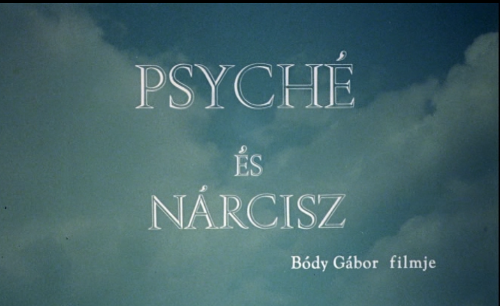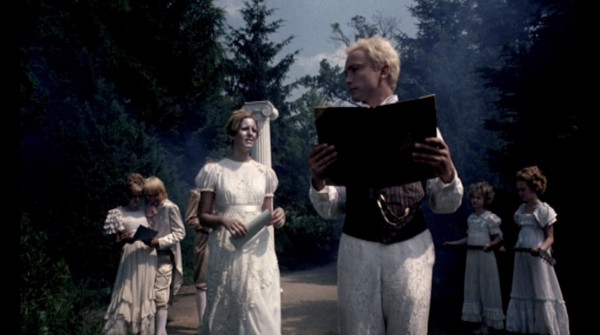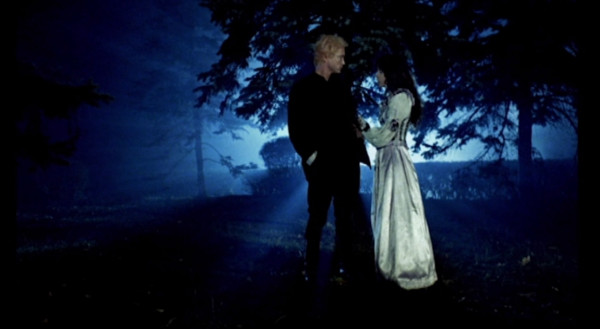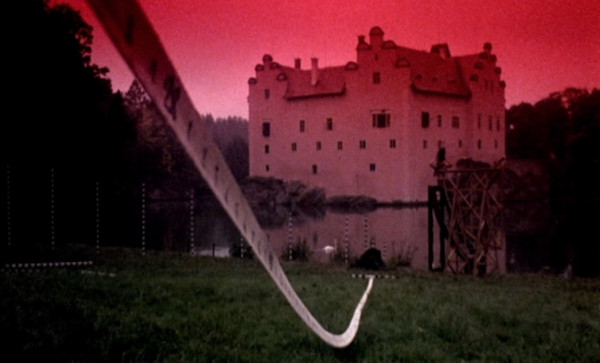actually, Gabor Bódy was the first one to use time lapse photography in a feature film…

I mean, this article is not what it seems. This is not someone's claiming that his favorite movie director did something earlier than others'. Besides, Koyaanisqatsi has been not only a favorite of mine, too, since ever, but as a matter of fact, I saw it first, before even knowing that such a movie director as Gabor Bódy even existed. Seriously, this is all for the record only… for history writing's sake, which is a funny statement today anyway, being deep in in the post-postmodern era, also known as the post-historical age.
Okay, the facts. Gabor Bódy, a young Hungarian filmmaker, extraordinarily talented, in the late '70s and early '80s, made a film Narcissus and Psyche, aka Psyche (this is how everybody would refer to it verbally, not independently of the fact that the book's title on which it was based was that, Psyché). He was exactly like David Lynch, that is, he had made his film school diploma film, a black and white feature film (American Torso, Eraserhead, respectively), and his actual first movie was, thus, his second movie already.
Psyché was not what you would expect of a 30 something year old freshmen in film industry. It was by far the greatest budget Hungarian movie of its time. But not just that. It was also an unprecedentedly “new” film in so many ways. Gabor Bódy spoke of a “new style”, a “new seeing”, a new manner which would transform everything, including the age of movies into the upcoming age of videos! He was like an agent in the field with a mission to complete, he was working very fast and very consciously. By the time he got to start planning his first feature film, he had checked the following:
-
went to a university and studied semiotics
-
had studied film language, including working as a script doctor for older filmmakers (who were already in the film school)
-
had made his own theory on film language
-
had acquired an extensive and deep knowledge in history, and had studied philosophy
In film school he checked the following:
-
had made experimental films, experimenting with film language, and his theory…
-
had made a narrative film with totally “experimental” story-telling methods… putting his theory in practice…
-
made another one like that, but it was a feature film “already”
The point is, when he got to preparing Psyche, he was already an expert on history and philosophy, and film language – “attribution of meaning in cinema” was the title of his diploma thesis at film school – a brilliant new talent who was popular because he spoke the new language of cinema… and was fresh and cool and good looking, and totally charismatic…

When he and his also young friend, the writer, Vilmos Csaplar, decided to make an adaptation of the book Psyché, Gabor Bódy already had a great deal of knowledge and experiences to carry out even such an unbelievably BIG project as it would be. Following the screenwriter Vilmos Csaplar's beautiful idea, that the young poetess, Psyché, would travel through time, like Virginia Woolf's Orlando – Sally Potter's did not exist yet, nevertheless, Orlando has never been mentioned either– her teens being in the early 1800, and by the time she's 30-something, it would be past 1933 (we can recognize this because there is a scene with Hitler's voice shouting in the phone).
It was an extraordinary movie from day one. The most of the most, the top of the top. To this, we should add that Gabor Bódy was very-very fashionable and popular in artist circles, he was quite a phenomenon, to say the least – his friend, Vilmos Csaplar, likewise was not only a brilliant mind, a young and talented writer, but also a great looking cool guy – there is a cameo of the two of them in the film and it is quite something.

Gabor Bódy was a professional screenwriter since his twenties, yet “writing” Psyché was not what it would be in most filmmakers' case. It was not about writing a screenplay, which was mainly done by Vilmos Csaplar anyway. The screenplay was “only” part of the writing, the creating of the battle plan of making the movie. Characteristic of Gabor Bódy, he was composing the movie VISUALLY from the start. Where the scene would be, and who and how would act, and what music would be in the background, and what audio special effects, were all part of the planning, of the writing.
Planning the camera work was an entire master-thread of all the preparations. He was a wild experimental young guy. An avant-garde. As his actor friend, György Cserhalmi told it, his original cinematographer friend from one of his previous films, was taken off the crew by the film corporation, early on, and an older gentleman was placed there, Istvan Hildebrand, who was not famous of experimental cinematography at all. Characteristic of Gabor Bódy, he was not taken aback to the slightest extent, but to the contrary! He looked at what good this would mean for his project, to have to work with a master cinematographer :) As it turned out, an immensely great deal!

Gabor Bódy centralized his “army” of artist around himself, too, but basically around the project. He – as it appears to me – had several “communication channels” for artists, working in different departments, and he carried on a conversation with each of them. While it is normal in most cases that the director only works together with her/his main actors, and the cinematographer, and the rest is given out to the industrial crew, Gabor Bódy opened a working channel with every department. There was no industrial crew, even the extras department was in his friendly hands, taking care of how it went personally, keeping up a personal contact with the department – an organizer from the extras department, years after Gabor Bódy died, told me (an extra in a Canadian production in Budapest) how much she had loved working with Gabor Bódy, and how exceptional it was to work with him.
As I see it, he was present to every artist working on the movie, in the dedicated channel, and – this is the point – he was there as an artist friend, making sure that the given artist would work FREELY, having all the inspiration she or he needs to get and to keep going.
the master of cinema and the young avant-garde
About the friendship with Istvan Hildebrand, I'm sure, an entire movie could be made, and likewise, about other friendships and working threads, too. With Hildebrand, he overcame the gap age and experience, and on his part, being an avant-garde and planning an unprecedentedly NEW, and revolutionary movie, must have brought about. As we know it from Cserhalmi, he explained Hildebrand all about his theory on narration and meaning, and cinematography, and his entire visual concept, as part of the “new seeing”.
And it all went through. By which I'm not saying that the cinematographer did what Gabor Bódy told him. NOT AT ALL! To the contrary, basically nobody did what they were told in the making of that movie. Instead, everybody was liberated, everybody was inspired and gotten going. Psyché is not the work of one man with the assistance of many artists, helping their friend, Gabor Bódy. No, Psyché was made by a huge number of artists, all working freely and inspired. Gabor Bódy didn't tell Istvan Hildebrand what to do. He – as I imagine – established a conversation with the master of cinematography, by which he could get him involved in his plan :)

If we want to imagine the young avant-garde starting work with the traditional gentleman and master of cinematography, we should also see that Gabor Bódy loved tradition, to the utmost! He loved religion, loved history, loved traditional things. He loved wearing old suits, for example. Loved looking like someone from the 1930s, or 1890s, for example :) He loved timelessness in some sort of sense – loved pretending that he was part of history, too, although he was totally aware that he lived on the edge of history, in a transitory era, before history would dissolve, “terminate” (as he had written about it in his amazing sci-fi novel at around age 20, which would have been his next movie project in 1986-87, had he still lived).
The friendship of the two couldn't be more productive! This would definitely need the young avant-garde to display an enormous knowledge on history and cinema, and cinematography, for which the elderly master would likewise respect him, and open himself artistically for the project.

Gabor Bódy would communicate with him about scenes during preparation like “it is like this and that symphony by this and that composer” – sorry, I don't remember the details, hence the “this and that” part… And the master would know exactly what the young avant-garde meant! He, the cinematographer would bring his huge suitcase, full of all kinds of filters (!!), and they would work on the “mood” of the scene – oh, I didn't mention, every scene has a decidedly different “mood”, visually expressed, so much so that watching the movie is like going through film history, starting with the naive, simple and bright style, and ending up using even video footage.
time lapse photography
Using time lapse photography was not one spectacular thing in the 3 hour movie (to take the shorter version with only two parts, cause the 3 part version is almost 4 hours – oh, one thinks here, if only the amazing David Lynch had had a chance to make his Dune be as long as the story demanded!). Time lapse was not a decorative element placed in a movie to spice it up. Not at all. It was organic part of the NEW STYLE, the “new seeing”: He explained it back then, in a letter, too, that there was nothing new about time lapse at all, cause experimental filmmakers had used it quite extensively. It was only, he explained, that in a feature movie it was unusual to apply experimental cinema's achievements, techniques. He was, however, at home with all experimental cinema, including not only Super-8 but video, too!

In that letter, where he wrote about this, he also mentioned to that producer, Mr. Daumer, that he had to hurry up, cause if he couldn't finish this totally NEW, as in NEW STYLE and completely NEW, movie, others would make movies anyway using elements of the new visual style, and he, coming out a year late, would become his own plagiarist :) The representatives of the new style, he wrote, would come up like worms after rain. So he had to hurry up.
He started to work on the film in 1976 (or 77), just after finishing his diploma film, and after two years of preparations, principal photography began, and by the end of 1980, 'Xmas time, it was in the Hungarian cinemas, and it was also then that Gabor Bódy and his fiancé Veronika Baksa-Soós got married. That is, all plots had reached a beautiful end.
Koyaanisqatsi
Koyaanisqatsi, the amazing film by Godfrey Reggio and Ron Fricke, and Philip Glass, is truly a unique entry in visual culture's history. The prototype of “the experimental movie”, the prototype of the movie “visually composed” (note that basically all Hollywood / industrial movies are composed in verbal language), most importantly, the prototype of the self-unfolding, visually composed, reflective movie making method, which is what video is the very means of! The prototype of the movie that was first shot and then thought up in terms of what it was about! The prototype of the movie that writes itself, the movie that is an analysis of reality. Yes, truly a prototype, an essential instance of all this, only it was never followed by “another instance”. Even the “sequels” were a completely different thing.
As to the time lapse “competition” :) Both Koyaanisqatsi and Narcissus and Psyche were in the making already years before completion. They both were ongoing projects in the late '70s. That Narcissus and Psyche happened to be out already by December 1980, only matters cause its director was racing with time. Even one year delay would have robbed his film of its truly cutting-edge, pioneer quality. Gabor Bódy didn't just want to make this movie, but he wanted to finish it in 1980. That's why he and his project deserves an honorable mention when it comes to which was the first ever movie, a significant, big feature movie, to use time lapse photography. See? Even the definition of this category is obviously lame. Gabor Bódy also pointed it out, it was not a new thing, it had been widely used by filmmakers all over the world, only not in big feature films.
Anyway, as much as marketing departments will try to highlight “records” about a product they want to sell, like the first ever whatever, I suggest we should never think of either of these movies as a first or a second, but rather, as regard them as parallel works of art. For that's what they are. Neither project's director or participants knew about the other one. They just worked on theirs, without thinking of anything else. We should, however, notice that the beauty in calling these two films parallel – parallel was one of Gabor Bódy's favorite terms – comes from the fact that both films are amazing… For it could have been otherwise, too… could be that there had been another movie before Koyaanisqatsi using time lapse photography, a feature movie with financial success, but a movie not worth seeing even the trailer of it… Could be. could have been… but luckily enough, these films are both extraordinary products of art history…
PS:
In my original hometown, not Budapest but a small one in the countryside, I could show you the exact spot where I had that conversation with that guy, a jazz club and film club organizer, a true inspirator, called Muranyi, telling him how much I had loved Koyaanisqatsi, shown some days before, to which he replied, smiling acknowledging my feedback, that “and there is another movie, exactly as amazing as this, Psyche, which also uses this fast motion thing, and it is really amazing”…


